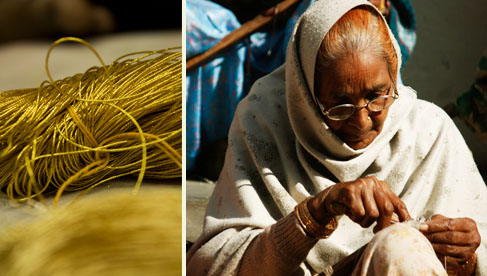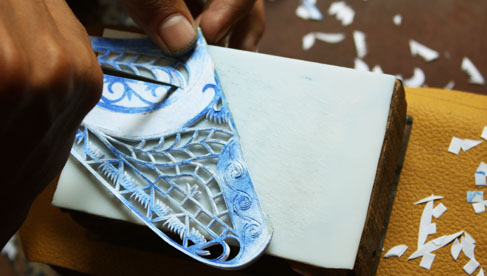Hello everyone!
We – that’s Pulkit & Simran are founder-owners at “Patrena“ ( literally meaning a vessel of gold ) ! We’ve been on the WorldArtCommunity platform for a while now and we thought we’d try to get to know you all a bit better and share a bit about what we do.
Our mission is to discover and explore our art and craft heritage. We travel through numerous towns and villages, discover craft and collaborate with artisans and craftspersons to curate collections of hand-crafted products that delight our aesthetic sense while preserving our cultural heritage.
Specifically – we work closely with craftspersons who specialise in creating “juttis” – inspiring them with our designs that are mix of the traditional and contemporary. While the men handle the cutting, and use stencils to cut and trace designs on to the leather pieces that make up the “jutti”, the women work beautiful embroideries on the top, back and sometimes even on the instep. The final product is again shaped and assembled by the men.
As traditional footwear worn by wealthy landowners and nobility in India – especially in Punjab – the humble “jutti “(also referred to as “khussa” across the border) has come a long way. And we’re proud of our humble effort, which we believe contributes to keeping the tradition alive.

Let us tell you a bit about the history and heritage of this craft.
Traditionally, the Mocha Jingo community of Rajasthan, who have now been settled in Punjab for several generations, made horse saddles, reins and footwear. The “jutti” were made across a large geography – extending from Udaipur to Hindumal Kot in Rajasthan. After 1947, most of them came to Punjab. Additionally – the family tradition of making “jutti” has been practiced in Patiala for the last 300 years by Raijer Mochis, who migrated from Sikal and Shekhawat in Rajasthan.
While traditionally made up of leather, with intricate embroidery in real gold and silver thread – design and material usage have evolved to so that the “jutti” now has several versions in different designs and variants, depending upon the creativity of the designer and even the craftsman who makes them. The cities of Amritsar and Patiala are important centres for manufacturing, trade and export of handcrafted “juttis”.
What makes “juttis’ unique? They have no left or right version and over time take the shape of the wearers’ foot. They usually have a flat sole, and are similar in design for both women and men, except for men they have a sharp extended tip that curves upwards.

Today the humble “ jutti “ – be it plain or embellished, in distinctive styles forms an integral part of ethnic and traditional wear for both men and women, both at ceremonial occasions or for everyday wear.
This is but one example of how we as artistic entrepreneurs work to bring alive our passion for craft and creation. Passion that is not limited to a sale – but is a process that begins with creation and extends to display and use where the product comes alive bringing joy to its owners.
Do check out and shop Patrena’s collection of “juttis” and crafts here
And we’d love to hear from you about what you think of us and our work ! Do share your comments.
Research and information from http://www.punjabheritage.in/event/tilla-jutti/
